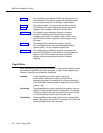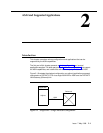
ASAI and Capability Groups
1-2 Issue 7 May 1998
Capabilities
While capabilities are grouped by the services they may provide, all groups divide
their particular capabilities into three categories or types. These categories are:
initiating, controlling, and terminating capabilities.
Routing This capability group allows the ECS to ask the adjunct for a
call’s destination. The adjunct supplies the destination based
on call-related information (for example, called number).
Request
Feature
The single capability in this group lets the adjunct request
ECS features, such as the agent login, logout, work mode
changes, Call Forwarding, and Send All Calls (SAC).
Value Query This capability group enables the adjunct to request
information regarding the ECS resources. Using this
capability group would, for example, allow a user to query
the ECS for the number of agents currently logged in to an
ACD split.
Set Value This capability group enables the adjunct to set the
ECS-controlled services, such as the Message Waiting
Indicator (MWL), for any specified telephone set.
Maintenance This capability group enables the adjunct to suspend and
resume the ECS alarms on the ASAI link. It also enables the
adjunct or the ECS to request the status of the ASAI
software at the remote endpoint using the Heartbeat
capability.
Initiating These capabilities are used to open a channel of
communication between the adjunct and the ECS for
messaging purposes. An example of an initiating capability is
Third Party Make Call that allows the adjunct to direct the ECS
to place a call.
Controlling These capabilities are used to exchange information once the
channel of communication has been established. For example,
Third Party Selective Hold can be used to place a call on hold,
or Third Party Merge can be used to transfer a call.
Terminating These capabilities end or close the channel of communication
between the adjunct and the ECS. For example, Third Party Call
Ended indicates that the call has ended.


















